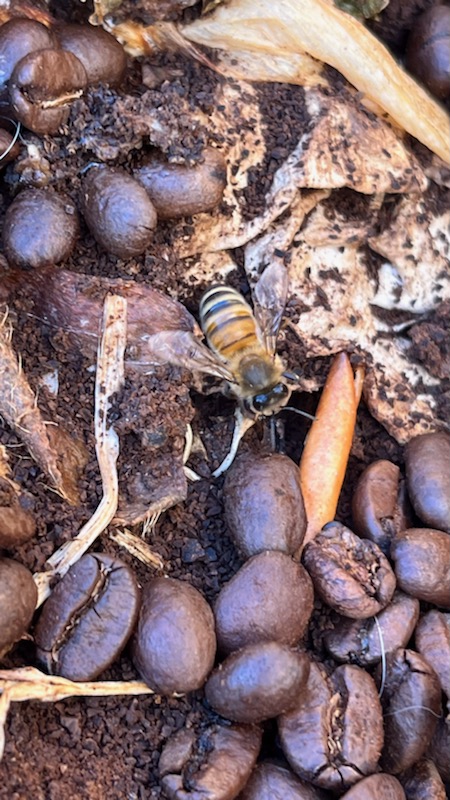What’s the buzzzzzz?
Article by Monika Smith
We’ve had a quirky winter. A lot of warm spells, quite the snowfalls and snow shovelling this year. According to a discussion on CBC radio, March was a doozy. Some 70 cm of snow fell, when the normal is 20! But don’t get too excited, as that amount of snow doesn’t translate into a lot of water going into our soils.
There’s very little activity in a garden in winter, but all is in readiness for continuous warmth luring leaf and flower.
Including the honeybee (Apis mellifera)! A sighting in March was astonishing. First thought was a native bee: the solitary hover fly. But, no, it was a honeybee.
The honeybee arose in Asia and expanded into Europe and Africa. It seems that bees have been around for some 30 million years and humans have been gathering honey for some 15,000. This insect was introduced from Europe to North America in the 1600s. Today, Alberta has the largest beekeeping industry in Canada, representing about 40% of honeybees. Of note, Fahler, Alberta (Peace County) is the Honey Capital of Canada. This insect is easy to manage and produces large quantities of honey. It’s also a eusocial insect, the highest level of animal sociality that a species can attain. The honeybee lives in large colonies, with a division of labour.
The honeybee is considered a ‘domestic’ species and in our colder climate need help. Beekeepers provide shelter and access to honey, but bees keep themselves warm by forming tight clusters with the queen and brood at the centre surrounded by heat-generating bees. This uses a lot of energy. They need to consume stored honey or starve. Beekeepers insulate hives and provide sugar syrup for their energy needs.
But as it gets warmer, they do emerge to defecate and clean up. And, if there is consistent warmth, they think it’s spring.
A photo of a bee motoring on Mike Sander’s compost pile in March, was astonishing. He’s Glendale’s Garden coordinator and interested in native plants.
I checked several sources about honeybees out at this time of year. I asked Dr Ken Fry, entomologist, and professor at Olds College, and he said ‘yes’ that was a honeybee, and possibly, there was a fungus secreting something sugary in the compost heap. I checked with local beekeeper and authority, Bruce Aitkens. Yes, this area has bees and keepers. In the mild temperatures, ten-ish plus, they are out foraging. Another source at Bee City suggested that bees like coffee grounds! Bees are pollinators, but quite fussy little divas with what flowers and nectar they like. Native bees are more important in this role. Check out the Alberta government website on honeybees and/or the Alberta Beekeepers Association.
What do you see happening at the hall’s yard in the future? See me at the hall during Neighbour Day, June 15 for a chat, and join me for a Jane’s Walk, May 5 at 10:00 am at the Hall, to talk and chat about our wonderful, treed community and how to keep them healthy!
Until next time,
Monika’s Grove


A honeybee, out and about in March. Photo courtesy of Mike Sanders.
Click here to the Glendale Community News home page for the latest Glendale community updates.











